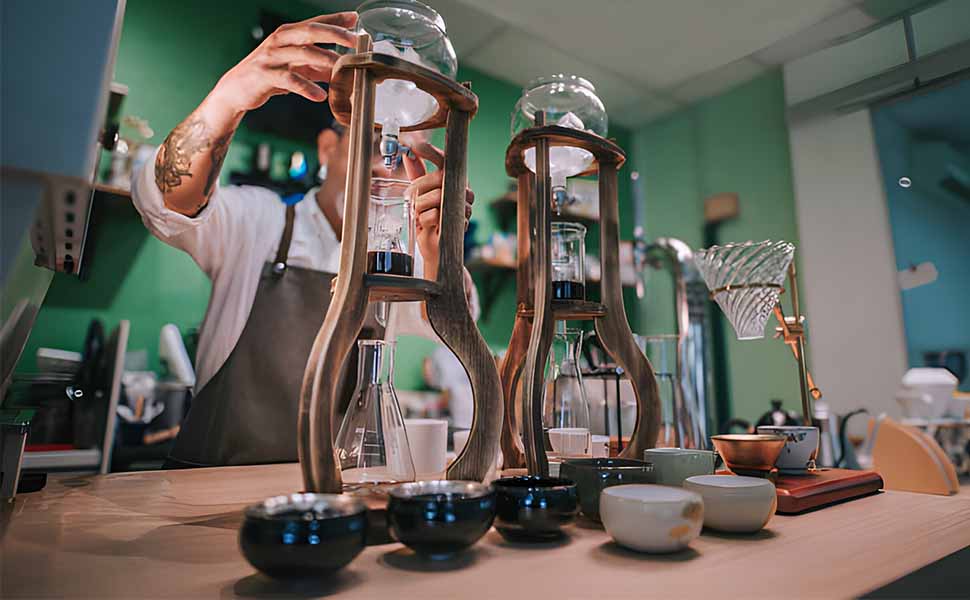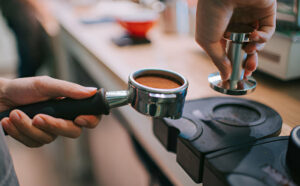-
Empty cart
No products in the cart.
Return to Shop

10 Must-Have Essentials for Perfect Espresso Coffee
Brewing the perfect espresso at home starts with having the right tools. Each piece of equipment plays a vital role in crafting a rich, flavorful

You’re probably familiar with cold brew coffee by now. In simple terms, it’s coffee extracted through immersion, either at room temperature or in a refrigerated environment, for a duration ranging from 12 to 24 hours (sometimes even longer). Some are concentrated while others are ready to drink directly. Making cold drip coffee at home, also known as Kyoto drip or iced drip, is quite straightforward. The tools for home use are simple, effective, and affordable, offering plenty of options.
Features of Cold Brew Coffee:
Key Points: The caffeine content in coffee primarily depends on its species; for instance, Robusta beans contain nearly twice as much caffeine as Arabica beans.
Q: Apart from the coffee species, are there other factors affecting caffeine content, such as roasting?
Matt Swenson, Director of Coffee at Nestle Partners, notes that the roasting process doesn’t break down caffeine, implying that different roasting profiles have limited impact on caffeine content. Therefore, the concentration and brewing ratio in cold brew, rather than roasting or coffee processing methods, determine caffeine levels.
Is cold brew coffee higher in caffeine content than pour-over coffee? A: Not necessarily. It depends on whether the cold brew is consumed as a concentrate or diluted.
Q:Does a longer cold brew extraction time result in more caffeine extraction?
A: Not necessarily. The difference in caffeine content is not due to brewing methods but rather the strength of the beverage when consumed.
Q:Some say cold brew coffee has 10% to 30% higher Total Dissolved Solids (TDS) than pour-over coffee.
A: Yes, but cold brew coffee is usually diluted before consumption.
Q:Is there a point where, regardless of how long cold brew is brewed, caffeine content doesn’t increase?
A: Yes. In hot brewing methods, about 90% of extractable caffeine is extracted within 5 minutes and 54 seconds. In cold water extraction, caffeine extraction is rapid in the first 180 minutes and then plateaus.
Q:Is higher cold brew concentration directly proportional to higher caffeine content?
A: Yes, but the impact of steeping time on caffeine content is limited.
*Data from Megan Fuller and Niny Z. Rao’s 2017 study “The Effect of Time, Roasting Temperature, and Grind Size on Caffeine and Chlorogenic Acid Concentrations in Cold Brew Coffee”.
Pro Tips If you’re concerned about caffeine content in cold brew, consider these methods to reduce it:

Brewing the perfect espresso at home starts with having the right tools. Each piece of equipment plays a vital role in crafting a rich, flavorful

Hey there, fellow coffee aficionados! Have you ever witnessed the mesmerizing dance of espresso flowing freely from a bottomless portafilter? If not, prepare to be

If you’ve ever made espresso, you’ve probably heard the tip to press the coffee powder hard with a coffee tamper to ensure a good extraction.

Have you ever thought about the relationship between freshness and flavor? We pursue freshness because we want our coffee to taste good, right? After all,
Copyright 2024 © All rights Reserved. Design by EspressoFree

How can we help you?